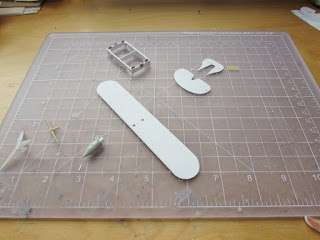The Italian Macchi M.39 was a racing seaplane designed specifically to compete on the Schneider Trophy of 1926, which it won, piloted by Mario de Bernardi.
Five similar machines were built, three for racing purposes with a Fiat AS.2 engine (the other two flown by Ferrarin and Bacula), and two for training purposes which had a similar but less powerful Fiat engine.
They followed the design lines that were found by almost all competitors to work better, namely twin-float braced monoplanes, of extremely refined streamlining that used surface radiators.
As I mentioned in previous threads, before even thinking of building, I dedicate time and effort to research, which invariably pays off big time. And this is no exception.
To start with, many photos captioned as a Macchi M.39 are actually of the very similar (but not identical) Macchi M.52 and 52R. Therefore the first task is to sort out the photos, helped by three clues:
-The M.52s had a much pronounced arrow angle for the wings
-The M.52s had slightly larger wing radiators
-The M.52s had different motifs on the fuselage and tail.
-The M.52 had a slightly different windshield.
(Four, four clues -Nobody expects the Spanish Inquisition)
After studying from photos you promptly realize:
-that representations of the M.39 in drawings and 3views are often inaccurate, since they include the graphic motifs that the M.52 had. As the winner of the Schneider, the M.39 had only the number 5 on the sides, no Italian tricolore on the rudder, and no fascia roundel on the fuselage.
-that the machine at the Vigna di Vale museum has a different, much later scheme than that worn at the race, and a wooden prop, used only on the practice machines, and not the Reed metal prop used on the race.
-That the windshield of the museum machine is again slightly different than the one seen in photos of the winning machine.
As an additional achievement, the Macchi M.39 established soon after the Schneider win a new speed record.
(Links to Youtube clips)
https://www.youtube.com/watch?v=Hsd3elDCvgs
Other contestants (next year, 1927):
https://www.youtube.com/watch?v=YcrDPiGWIus
Naturally -as universally known- all available plans differ in some minor way among them, and all also differ, to some degree...from reality.
This is a very common occurrence, and I don't fuss over it too much, also given that when you (or anyone else) prints a plan you are further introducing dimensional changes related to printer, type of file, etc.
I start to pay attention when discrepancies are noticeable. In this case it's the floats' length.
Study showed that, predictably, several were tried, and the stated numbers in sources may refer to any of those, but the ones on the plans (although there are variations) are generally a tad short compared to actual photos, so I will agree, as usual, with the photos.
At this point I already got the floats done (to my relief, because it is a sticky point in this type of scratchbuild) adapting some from the generic Aeroclub vac sheet, of which I still have a few treasured partial sections.
The rest will be solved as usual with a carved wood fuselage and styrene sheet flying surfaces, as per other related scratchbuilds, plus the addition of lengths of Contrail and Strutz airfoiled material.
(Don't you love how you can theorize freely, and all goes fantastically well?)
One particular detail to have in mind as you build the wing is that the panels were asymmetric, the left wing a bit larger in span to compensate for the brutal torque of the powerful engine.
Tail feathers:
As they say: The ordnance of a wrathful man is the racer spinner of the peaceful one.
The future spinner:
A beaching dolly is drawn and built:
Now the floaty bits have a place to rest:
The wing is made. Later on it will be cut and given the corresponding swept-back:
The wood blanks for the fuselage are cut:
The blanks are pegged together:
And the shape is being carved:
The process of sanding away what it doesn't look like Macchi M.39 fuselage starts:
The build was rendered redundant as SBS produced a kit of this plane.
I was surprised, because Murphy's Law states that you have to first finish your scratchbuilding efforts for a kit to be released. This has been confirmed by my scratchbuilds of the Lee-Richards Annular Wing, Farman F.231, Northrop Conqueror Gamma conversion, Caproni Stipa, Nemeth Umbrellaplane, Pou-du-ciel, American Gyro Crusader, Farman F.197, Curtiss Robin, Monocoupe, SARO Cutty Sark, Avia BH-1, and a few others for which kits were later released.












No comments:
Post a Comment